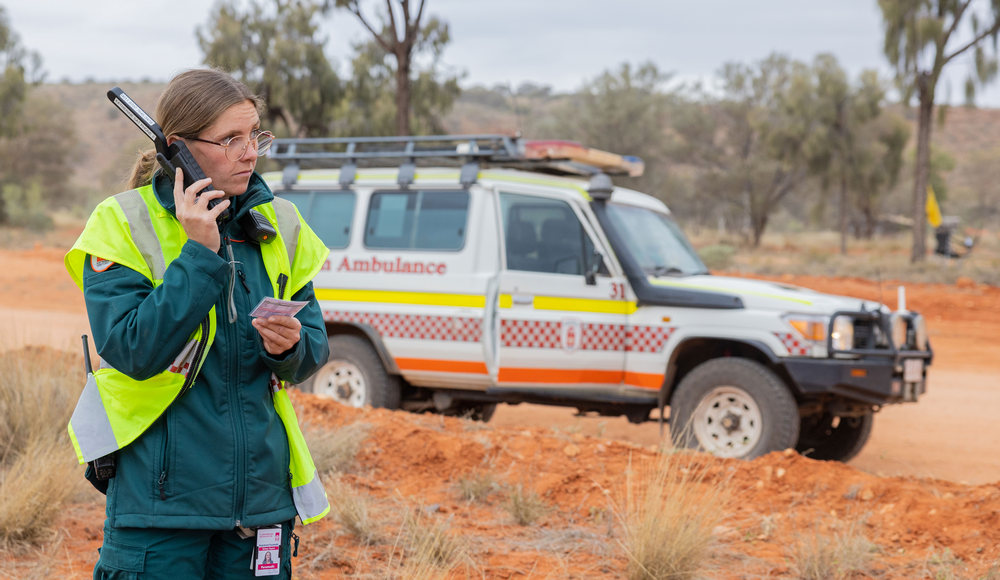
By Miranda Lewis, Advanced Care Paramedic, Queensland Ambulance Service
Mitchell, Queensland, Gunggari Country
The paramedicine profession as significantly expanded since it’s humble inception as a transport service from emergency scenes to hospital. Gone are the days of the “you call, we haul” mentality. Most services today now boast a variety of skill sets from specialised patient transport services all the way up to critical-care/high-acuity paramedics. Paramedicine’s ability to adapt to changing situations and evolving patient presentations is what gives us an edge when it comes to moving forward in our profession.
It makes sense then, when our healthcare systems started to feel an increased demand (1) across the globe, that paramedicine would rise to the occasion. The idea of community paramedicine is not a new one worldwide, but it is growing rapidly (2) and is likely to form a core component of paramedicine as we progress into the future.
In this article, we will discuss what community paramedicine could look like in practice in the rural and remote environment. As we begin this discussion, we must consider what community paramedicine aims to bring to the rural and remote community.
A community paramedicine program can enhance and assist the local healthcare system by providing support and services for patients in the community, with the flow-on effect of decreasing stress on local health infrastructure and staff. The aim of such a program isn’t to reinvent the wheel or create a standalone primary care service, but to provide a service that is integrated with the existing available services and expand these out into the community. (2) This might be achieved through initiatives such as:
**Referrals and health service integration **
Community paramedicine can provide a valuable link between patients in the community and health services that may require multiple steps to access. By integrating with local services such as x-ray providers, pathology or allied health, and increasing communication with local general practitioners, community paramedics can assist patients to access certain healthcare services in a more streamlined manner.
Consider
Consider the local football carnival held in a small rural town. The population of 800 has doubled due to the event. A single emergency ambulance works on-call. The local multipurpose health facility is running on limited staff with no x-ray available until Monday morning. The local community paramedic attends a patient who presents with a simple potential fracture, no obvious deformity, and is otherwise well. This patient could be transported to the local facility, where they would be transferred on to the next town for imaging, an exercise that depletes the town of an ambulance response and a senior clinical nurse for several hours. Alternatively, the community paramedic can treat the patient on scene, perhaps applying a back slab to the affected area or organise crutches to be available from the local health facility. They write a referral for an appropriate x-ray that the patient can receive when they return to their hometown and a follow-up letter to the patient’s usual GP. The community paramedic’s treatment reduces the burden on the local ambulance service and the local health service while also allowing for streamlined patient care.
Community clinics and education
Rural and remote communities, particularly in the Australian context, suffer greatly from the tyranny of distance. Despite this, rural communities are generally receptive to large-scale community health initiatives (such as the Heart Bus). (3) Community paramedics who are already integrated into the community are well suited to providing regular, advertised community clinics. These types of initiatives can improve health monitoring, health education and provide a sense of support for rural communities.
Consider
The local community paramedic as part of their portfolio organises a scheduled community clinic in each of the small localities in their response area. They take the time to travel to the localities (perhaps an hour or more away) and utilise available community infrastructure to provide a day of health monitoring, general check-ups, vaccinations, and health education. The community appreciates the reliable service, the effort being taken to bring healthcare to the locality, and the days are well attended as the positive community perception of the service grows via word of mouth. This increases the trust of the community in the local healthcare system and builds valuable relationships between the community and the first responders.
Hospital discharge support/home visits/community primary care
In many communities, community nursing programs are utilised to provide support to patients who have been linked through the existing healthcare system or through the aged-care system. Community paramedics have the potential to expand this further through a number of potential avenues. Multidisciplinary integration could occur through a collaborative approach with local GPs, hospitals, and community health services where community paramedics could provide supported home visits and follow-ups.
Consider
A small, one-doctor GP clinic attached to multipurpose health facility is contacted by a patient for a routine appointment as they are feeling a bit unwell. The receptionist advises that they don’t have an available appointment with the GP for at least a week. However, as an alternative, they ask if the patient would like a home visit from the local community paramedic. The community paramedic can attend to the patient later that afternoon and provide point-of-care-testing (POCT). Through POCT, the community paramedic is able to determine that the patient is likely suffering from a simple urinary tract infection. Through collaborative phone consultation with their GP, the community paramedic leaves the patient with an e-script for antibiotics and an appointment for further follow-up.
Integrated emergency responses
In some areas, community paramedics are being utilised alongside their emergency response counterparts to enhance emergency pre-hospital care. In the same way that on-road paramedics can identify a patient requiring critical care and request intensive care or critical care back-up, community paramedics can be dispatched to patients who require a more primary care approach.
Consider
A local crew attends the nursing home in town for a patient who requires a urinary catheter change, with no staff on shift currently qualified to do so. The paramedic realises that while they could transport the patient to hospital and back (approximately 60 minutes each way) they could also call their community paramedic, who could attend the scene and potentially mitigate an unnecessary hospitalisation for this patient. The community paramedic arrives, assesses the patient, and can successfully remove and replace the catheter. The referral of the on-road paramedic and the integration of community paramedicine into the emergency space has ensured that this patient can remain in their own home where they are comfortable while still receiving the care they require.
Conclusion
For those on the fence about the viability or necessity of programs like community paramedicine in our own rural and remote work areas, it’s important to remember that we likely already undertake a lot of these support actions in our roles as emergency paramedics.
Do you attend local health promotion events or perhaps provide health education or CPR awareness at local schools? Do you take the time to formally or informally follow up the patient that you didn’t transport the next day to ensure that they are still okay? Do you do informal checks on your elderly patients in the middle of summer when you know they won’t have the air conditioner on? If so, you are already providing some form of community paramedicine.
The investment in this area of our profession is exciting, and personally I can’t wait to see where it takes us in the future.
References
Shannon B, Eaton G, Lanos C, et al. The development of community paramedicine; a restricted review. Health & Social Care in the Community. 2022;30(6):e3547-e3561. [https://onlinelibrary.wiley.com/doi/10.1111/hsc.13985]
Spelten E, Thomas B, van Vuuren J, et al. Implementing community paramedicine: A known player in a new role. A narrative review. Australasian Emergency Care. 2024;27(1):21-25. https://doi.org/10.1016/j.auec.2023.07.003
Heart of Australia. 2024. Accessed from: www.heartofaustralia.com.au

Get unlimited access to hundreds of ACP's top courses for your professional development.
Join Now